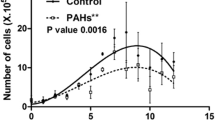Abstract
Exudates from the brown algaeCaepidium antarcticum andDesmarestia sp. were investigated for their ability to associate with hydrophobic pollutants such as polychlorinated biphenyls (PCB s). The percentage of PCB associated with algal exudates ranged from 79% for decachlorobiphenyl to 23% for the pentachlorobiphenyl congener No. 95. Exudates from the tested brown algae may therefore alter the bioavailability of PCBs in natural or artificial ecosystems.
Similar content being viewed by others
References
Anderson, RJ (1985) Morphological and taxonomic relationships among branched, ligulate members of the genusDesmarestia (Phaeophyceae, Desmarestiales), with particular reference to South AfricanD. firma. Can. J. Bot. 63: 437–447.
Boehm PD, Quinn JG (1976) The effect of dissolved organic matter in sea water on the uptake of mixed individual hydrocarbons and Number 2 Fuel Oil by a marine filterfeeding bivalve (Mercenaria mercenaria) Estuarine Coastal Mar. Sci. 4: 93–105.
Carlberg GE, Martinsen K, Kringstad A, Gjessing E, Grande M, Källqvist T, Sk»re TV (1986) Influence of aquatic humus on the bioavailability of chlorinated micropollutants in atlantic salmon. Arch. Environ. Contain. Toxicol. 15: 543–548.
Carlson DJ, Mayer LM (1983) Relative influence of riverine and macroalgal phenolic materials on UV absorbance in temperate coastal waters. Can. J. Fish. Aquat. Sci. 40: 1258–1263.
Carlson DJ, Mayer LM, Brann ML, Mague TM (1985) Binding of monomeric organic compounds to macromolecular dissolved organic matter in seawater. Mar. Chem. 16: 141–153.
Ernst W (1975) Eine neue Verbrennungs-IR-Methode zur Mikrobestimmung von organischem Kohlenstoff in marinen Sedimenten. Veröff. Inst. Meeresforsch. Bremerh. 15: 269–281.
Frank P (1972) Herbicidal residues in aquatic environments. In Gould F (ed.), Fate of Organic Pesticides in the Aquatic Environment. Advances in Chemistry Series 111. American Chemical Society, Washington D.C., 135–148.
Kukkonen J, Oikari A (1987) Effects of aquatic humus on accumulation and acute toxicity of some organic micropollutants. Sci. Total Environ. 62: 399–402.
Lara R, Ernst W (1989) Interaction between polychlorinated biphenyls and marine humic substances. Determination of association coefficients. Chemosphere (in press).
Leversee GJ, Landrum PF, Giesy JP, Fannin T (1983) Humic acids reduce bioaccumulation of some polycyclic aromatic hydrocarbons. Can. J. Fish. Aquat. Sci. 40: 63–69.
McLachlan J (1973) Growth media — marine. In Stein JR (ed.), Handbook of Phycological Methods. Culture Methods and Growth Measurements. Cambridge University Press, Cambridge, 25–52.
Moe RL, Silva PC (1977) Sporangia in the brown algal genusDesmarestia with special reference to AntarcticD. ligulata. Bull. Jap. Soc. Phycol. 25: 159–167.
Poutanen EL, Morris R (1983) A study of the formation of high molecular weight compounds during the decomposition of a field diatom population. Estuarine Coastal Shelf Sci. 17: 189–196.
Sieburth JMcN, Jensen A (1969) Studies on algal substances in the sea. II The formation of Gelbstoff (humic material) by exudates of Phaeophyta. J. Exp. Mar. Biol. Ecol. 3: 275–289.
Wiencke C (1988) Notes on the development of some benthic marine macroalgae of King George Island, Antarctica. Ser. Cient. INACH 37: 23–47.
Wiencke C, tom Dieck I (1989) Temperature requirements for growth and temperature tolerance of macroalgae endemic to the Antarctic region. Mar. Ecol. Progr. Ser. 54: 189–197.
Author information
Authors and Affiliations
Rights and permissions
About this article
Cite this article
Lara, R.J., Wiencke, C. & Ernst, W. Association between exudates of brown algae and polychlorinated biphenyls. J Appl Phycol 1, 267–270 (1989). https://doi.org/10.1007/BF00003652
Received:
Accepted:
Issue Date:
DOI: https://doi.org/10.1007/BF00003652




